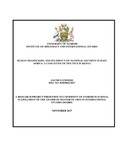| dc.description.abstract | This thesis is premised on the argument that organization of routine activities of individuals or groups in society fuels crimes such as human trafficking. The thesis argues that human trafficking is a threat to the whole society and that it undermines the populations’ fundamental rights and freedoms, health and safety thus posing a threat to national security.
The overall objective of the thesis is to examine the intensity of human trafficking and its impact on National Security in East Africa with specific reference to the countries of Kenya and Tanzania. Specific objectives include an examination of how human trafficking and terrorism relate, examining how human trafficking and trade in human body organs relate as well as examining the connection between prostitution and human trafficking.
The thesis seeks answers to the difference or similarity between slave trade (the old form of human trafficking) and the current forms of human trafficking in the 20th and 21st centuries in addition to why the problem of trafficking is found in weaker/vulnerable/fragile states only. The theory behind the research is the ‘Routine Activities theory’ which stresses the idea that criminals are not impulsive or unpredictable because they balance costs as well as the benefits of committing crime. The theory postulates that ‘organization of routine activities in society creates opportunities for crime.’ This simply means that the daily routine activities of individuals or groups of people and their socialization which include but is not limited to where they work, what they do and where they live strongly influence crime commitment. The theory further posits that routine activities arising from opportunities over time and space amongst people can make crime easy and low risk or difficult and risky to manage or eliminate. The theory suggests that crime can increase as well as decline without any change in the number of those involved in crime. It also identifies market availability, enabling environment and prevalence of bias in the justice system as additional factors that motivate individuals or groups of individuals to engage in crime over and above the traditional ones of social, economic and political drive and ambitions. Since the study seeks to examine root causes of human trafficking, nature and characteristics of the vice as well as existing prevention strategies and management measures that are in place, use of the routine activity theory was found relevant in explicating existing opportunity structures that facilitate the illicit trade.
The study will rely heavily on desk top research and oral interviews with selected key informants based on structured questions. In chapter one, I reflect on human trafficking in East Africa, the causes and characteristics of the crime. An examination of the intensity of human trafficking and its impact on National Security in East Africa with specific reference to the countries of Kenya and Tanzania is also provided. In chapter two I uncover how human trafficking and terrorism relate while in chapter three I offer an explanation of the relationship between human trafficking and trade in human body parts as well as the connection between prostitution and human trafficking. In chapter four I look at how corruption weakens security institutions in light of existing counter human trafficking and management strategies in East Africa. In chapter five I describe the extent to which the objectives have been met and also demonstrate the extent to which the stated hypotheses have been affirmed. In chapter six I conclude with recommendations on strengthening of regional security architecture to improve human and social security through establishment of a Regional Commission for Human Rights (RCHR) mirroring on the Office of the United Nations High Commission for Human Rights (OHCHR). | en_US |



